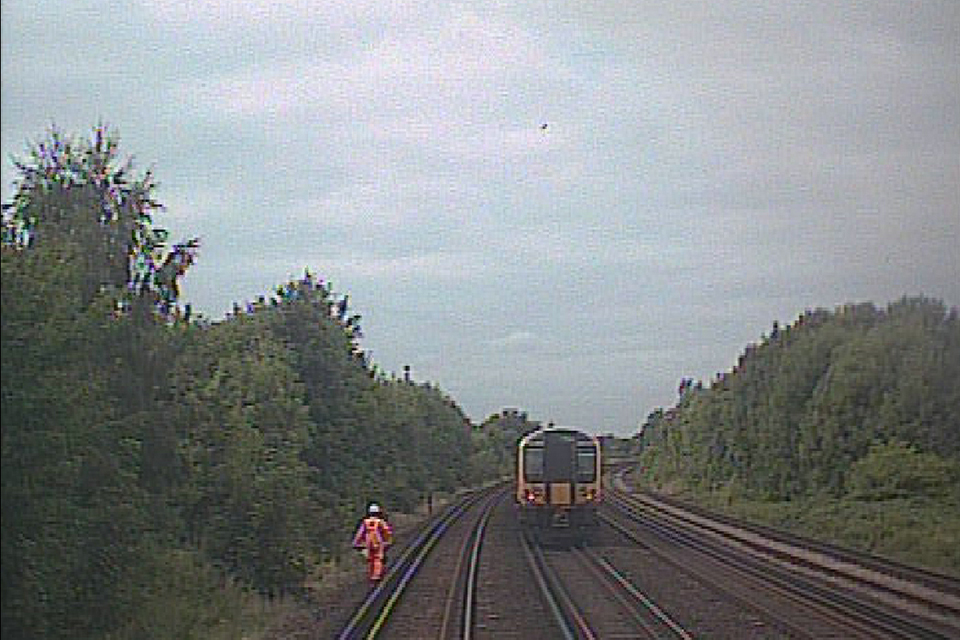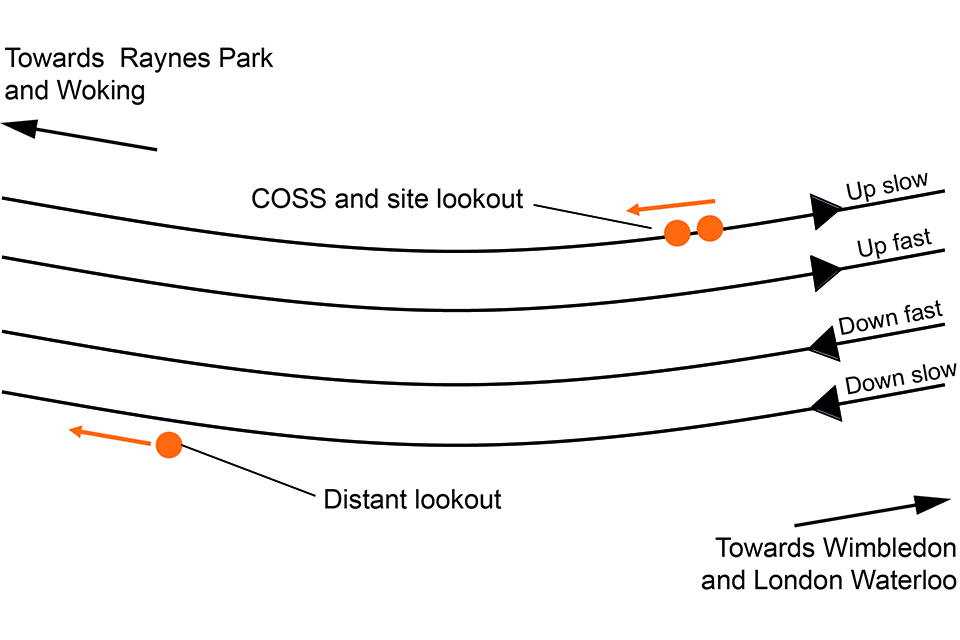Track worker struck by a train near Wimbledon, south-west London, 22 August 2017
Published 14 December 2017
1. Important safety messages
This accident demonstrates the importance of:
- distant and intermediate lookouts remaining in a position of safety and maintaining their awareness of their position relative to the track whilst undertaking their duties
- train drivers understanding that it can be particularly difficult to judge whether track workers are in a position of safety on curved track, and that they should provide urgent warnings to the track workers if they are in any doubt
2. Summary of the accident
At 12:07 hrs on Tuesday 22 August 2017 a track worker was struck a glancing blow by a train travelling at about 45 mph (72 km/h). The track worker was walking along the side of the line, with his back to the approaching train, and suffered minor injuries.

Forward facing CCTV image from the train that struck the track worker, looking towards Raynes Park, showing the rear of the first train having passing the distant lookout (courtesy of South Western Railway)
Earlier that morning a work group, consisting of three members of Network Rail staff, had completed a routine inspection of the track from Raynes Park to Wimbledon station. The inspection was being carried out by a patroller, who was also acting as the controller of site safety (COSS). The COSS had conducted his inspection from the area between the two rails of the down slow line, known as the ‘four-foot’, while the two other members of staff acted as lookouts (to warn of the approach of trains). The group walked 1.4 miles (2.25 km) between the stations, with the COSS inspecting both the down fast and down slow lines from the down slow line.

Schematic diagram showing the four lines and the relative positions of the COSS with the site lookout on the up slow (top), and the distant lookout near the down slow (bottom)
When the group reached Wimbledon they took a break before they began the return journey to Raynes Park. In this direction the COSS was inspecting the up fast and up slow lines from the four-foot of the up slow line. The system of work required a site lookout to be positioned with the COSS, and a distant lookout to be positioned about 200 metres further ahead and adjacent to the down slow line. The role of the distant lookout was to provide advance warning of trains approaching on the up lines because the track curvature restricted the site lookout’s view.
The distant lookout had walked around 1 mile (1.6 km) from Wimbledon when two trains approached his location on the down lines, travelling towards Raynes Park. The first train, the 11:54 hrs service from London Waterloo to Weymouth, was travelling on the down fast and the second train, the 11:47 hrs service from Waterloo to Woking, was travelling slightly behind on the down slow.
Witness evidence indicates that, as the trains approached, the COSS and site lookout moved from the track and into a position of safety. This was because the site lookout anticipated they would lose sighting of the distant lookout. Forward facing CCTV from both trains shows the distant lookout, apparently unaware of the second train approaching on the down slow line, walking by the side of that line with his back to the trains. He raised his hand before the train on the down fast passed him but did not look around towards either train.
The second train struck the lookout’s right elbow causing a laceration. He has since made a full recovery.
3. Cause of the accident
Handbook 7 of the railway rule book (GE/RT8000) requires a COSS to make sure that distant lookouts are located where there is a position of safety (however, if the site of work is mobile and distant lookouts walk while carrying out their duties, they may leave the position of safety when they need to pass an obstruction). Handbook 3 required the distant lookout to carefully watch for approaching trains on the up lines, to provide warning to the workgroup.
CCTV and witness evidence indicate that the distant lookout was unaware that his position put him in the path of trains on the down slow line. RAIB visited the site on the day of the accident and found the cess to be in good condition. RAIB could not identify a reason that would have required the distant lookout to leave a position of safety.
The second train approached the distant lookout round a right-hand curve. The driver’s view of the distant lookout was obscured, due to the position of the first train on the curve, from around 22 seconds (450 metres) until around 10 seconds (200 metres) before reaching the distant lookout. In a statement made to his employer, the driver stated he sounded the train horn twice: initially just after his view of the distant lookout became obscured and then again after he regained his view of the distant lookout.
Witness evidence indicates that members of the work group did not hear a warning from the second train. Use of the train horn is not recorded by the on-train data recorder on this type of train. Following the accident, the warning horn was tested by South Western Railway, and found to be working normally. It is possible that the noise from first train just ahead of it masked the warning from the second train.
Module TW1 of the rule book requires a driver to give a warning to anyone on or near the line. Additionally, it requires a driver to give a series of short, urgent, danger warnings to anyone who is on or dangerously near the line and who does not acknowledge the initial warning or who does appear to move clear out of the way of the train. However, it can be difficult for a train driver to judge whether someone at the side of the track is, or is not, actually in danger of being struck. This judgement can be particularly difficult when the line is curved, as at this location. The RAIB has seen no evidence to suggest an urgent warning was given by the second train.
4. Previous similar occurrences
Other accidents with similarities to the accident near Wimbledon also include:
-
Fatal accident at Whitehall West junction, Leeds, 2 December 2009 (RAIB report 15/2010). A westbound train struck and killed a track worker as it passed Whitehall West junction, near Leeds. The track worker, who was standing in the cess on a curve with his back to the train, was acting as lookout for a workgroup lifting and packing track at the junction behind him. He was looking for trains travelling in the less-used direction on a bi-directionally signalled line, and had moved close to the track without realising that he had done so. The train driver did not sound an urgent warning because he was unable to judge that the lookout was too close to the track.
-
Fatal accident involving a track worker, near Newark North Gate station, 22 January 2014 (RAIB report 01/2015). A track worker was struck by a passenger train as it approached Newark North Gate station. He was part of a team of three carrying out inspections on lines that were open to traffic and was acting in the role of lookout. The lookout and another track worker started the inspection near two crossovers. An approaching train blew a warning horn and the two staff acknowledged the warning and moved to the nominated place of safety. However, just before the train moved onto the first crossover, the lookout turned to face away from the train, walked towards the station and then out of the position of safety. Although the train braked and blew a second warning horn, the lookout did not turn to face the train until it was too late for him to take evasive action.
Both these accidents demonstrated the need for lookouts to remain aware of their own safety when undertaking their duties, and to check for approaching trains when leaving the position of safety.
You can print this safety digest.

